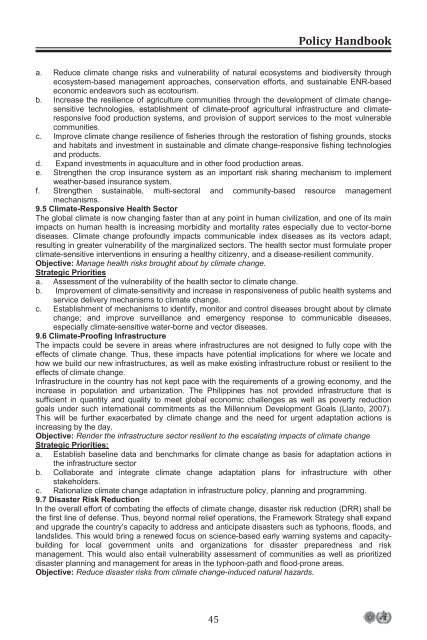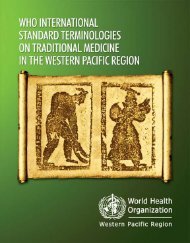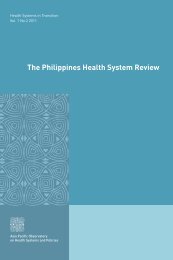Untitled - DOH
Untitled - DOH
Untitled - DOH
- No tags were found...
Create successful ePaper yourself
Turn your PDF publications into a flip-book with our unique Google optimized e-Paper software.
National Framework Strategy on Climate Change Policy 2010-2022 Handbooka. Reduce climate change risks and vulnerability of natural ecosystems and biodiversity throughecosystem-based management approaches, conservation efforts, and sustainable ENR-basedeconomic endeavors such as ecotourism.b. Increase the resilience of agriculture communities through the development of climate changesensitivetechnologies, establishment of climate-proof agricultural infrastructure and climateresponsivefood production systems, and provision of support services to the most vulnerablecommunities.c. Improve climate change resilience of fisheries through the restoration of fishing grounds, stocksand habitats and investment in sustainable and climate change-responsive fishing technologiesand products.d. Expand investments in aquaculture and in other food production areas.e. Strengthen the crop insurance system as an important risk sharing mechanism to implementweather-based insurance system.f. Strengthen sustainable, multi-sectoral and community-based resource managementmechanisms.9.5 Climate-Responsive Health SectorThe global climate is now changing faster than at any point in human civilization, and one of its mainimpacts on human health is increasing morbidity and mortality rates especially due to vector-bornediseases. Climate change profoundly impacts communicable index diseases as its vectors adapt,resulting in greater vulnerability of the marginalized sectors. The health sector must formulate properclimate-sensitive interventions in ensuring a healthy citizenry, and a disease-resilient community.Objective: Manage health risks brought about by climate change.Strategic Prioritiesa. Assessment of the vulnerability of the health sector to climate change.b. Improvement of climate-sensitivity and increase in responsiveness of public health systems andservice delivery mechanisms to climate change.c. Establishment of mechanisms to identify, monitor and control diseases brought about by climatechange; and improve surveillance and emergency response to communicable diseases,especially climate-sensitive water-borne and vector diseases.9.6 Climate-Proofing InfrastructureThe impacts could be severe in areas where infrastructures are not designed to fully cope with theeffects of climate change. Thus, these impacts have potential implications for where we locate andhow we build our new infrastructures, as well as make existing infrastructure robust or resilient to theeffects of climate change.Infrastructure in the country has not kept pace with the requirements of a growing economy, and theincrease in population and urbanization. The Philippines has not provided infrastructure that issufficient in quantity and quality to meet global economic challenges as well as poverty reductiongoals under such international commitments as the Millennium Development Goals (Llanto, 2007).This will be further exacerbated by climate change and the need for urgent adaptation actions isincreasing by the day.Objective: Render the infrastructure sector resilient to the escalating impacts of climate changeStrategic Priorities:a. Establish baseline data and benchmarks for climate change as basis for adaptation actions inthe infrastructure sectorb. Collaborate and integrate climate change adaptation plans for infrastructure with otherstakeholders.c. Rationalize climate change adaptation in infrastructure policy, planning and programming.9.7 Disaster Risk ReductionIn the overall effort of combating the effects of climate change, disaster risk reduction (DRR) shall bethe first line of defense. Thus, beyond normal relief operations, the Framework Strategy shall expandand upgrade the country’s capacity to address and anticipate disasters such as typhoons, floods, andlandslides. This would bring a renewed focus on science-based early warning systems and capacitybuildingfor local government units and organizations for disaster preparedness and riskmanagement. This would also entail vulnerability assessment of communities as well as prioritizeddisaster planning and management for areas in the typhoon-path and flood-prone areas.Objective: Reduce disaster risks from climate change-induced natural hazards.4545
















